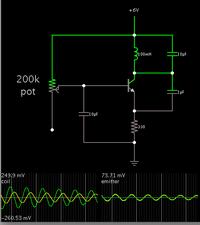Follow along with the video below to see how to install our site as a web app on your home screen.
Note: This feature may not be available in some browsers.

After sending my post I saw Not-a-moderators's post. I agree with what he stated.
The colpitts oscillator circuit mostly shown in text books, also in this link https://en.wikipedia.org/wiki/Colpitts_oscillator uses a capcitive volateg divider instead of a high-pass feedback. Both circuits can work as an oscillator, but I prefer the classical circuit.However, a closer look reveals that this feedback path consists of Cf and the emitter resistor forming a high pass with a corresponding phase shift.
So - how do we get a loop gain with 0 deg phase shift?
Besides the fact that he has copied it from the referenced link I have the feeling that the role of the feedback capacitor Cf is not explained up to now.
It seems to be very easy to say "the tank circuit oscillates and Cf provides positive feedback."
However, a closer look reveals that this feedback path consists of Cf and the emitter resistor forming a high pass with a corresponding phase shift.
So - how do we get a loop gain with 0 deg phase shift?
Answer: The frequency of oscillation is not identical to the tank center frequency (with phase 0 deg) but displaced by a certain amount - causing a phase shift which can compensate the unavoidable phase shift in the feedback path.
That is the reason, the formula for the oscillation frequency contains both capacitors.